
A deer or true deer is a hoofed ruminant ungulate of the family Cervidae. It is divided into subfamilies Cervinae and Capreolinae. Male deer of almost all species, as well as female reindeer, grow and shed new antlers each year. These antlers are bony extensions of the skull and are often used for combat between males.

Antlers are extensions of an animal's skull found in members of the Cervidae (deer) family. Antlers are a single structure composed of bone, cartilage, fibrous tissue, skin, nerves, and blood vessels. They are generally found only on males, with the exception of reindeer/caribou. Antlers are shed and regrown each year and function primarily as objects of sexual attraction and as weapons.
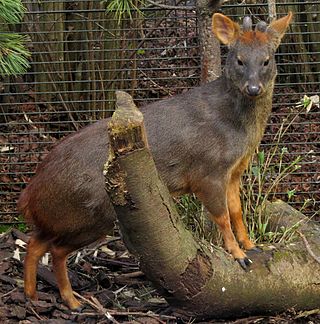
The pudus are two species of South American deer from the genus Pudu, and are the world's smallest deer. The chevrotains are smaller, but they are not true deer. The name is a loanword from Mapudungun, the language of the indigenous Mapuche people of central Chile and south-western Argentina. The two species of pudus are the northern pudu from Venezuela, Colombia, Ecuador, and Peru, and the southern pudu from southern Chile and south-western Argentina. Pudus range in size from 32 to 44 centimeters tall, and up to 85 centimeters (33 in) long. The southern pudu is classified as near threatened, while the northern pudu is classified as Data Deficient in the IUCN Red List.
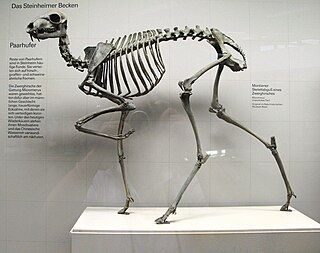
Moschidae is a family of pecoran even-toed ungulates, containing the musk deer (Moschus) and its extinct relatives. They are characterized by long 'saber teeth' instead of horns, antlers or ossicones, modest size and a lack of facial glands. While various Oligocene and Miocene pecorans were previously assigned to this family, recent studies find that most should be assigned to their own clades, although further research would need to confirm these traits. As a result, Micromeryx, Hispanomeryx, and Moschus are the only undisputed moschid members, making them known from at least 18 Ma. The group was abundant across Eurasia and North America during the Miocene, but afterwards declined to only the extant genus Moschus by the early Pleistocene.

The sika deer, also known as the Northernspotted deer or the Japanese deer, is a species of deer native to much of East Asia and introduced to other parts of the world. Previously found from northern Vietnam in the south to the Russian Far East in the north, it is an uncommon species that has been extirpated in most areas of its native range, except in Japan, where it is overabundant and present in very large numbers.

The Irish elk, also called the giant deer or Irish deer, is an extinct species of deer in the genus Megaloceros and is one of the largest deer that ever lived. Its range extended across Eurasia during the Pleistocene, from Ireland to Lake Baikal in Siberia. The most recent remains of the species have been radiocarbon dated to about 7,700 years ago in western Russia. Its antlers, which can span 3.5 metres (11 ft) across are the largest known of any deer. It is not closely related to either living species called the elk, with it being widely agreed that its closest living relatives are fallow deer (Dama).

The chital or cheetal, also known as the spotted deer, chital deer and axis deer, is a deer species native to the Indian subcontinent. It was first described and given a binomial name by German naturalist Johann Christian Polycarp Erxleben in 1777. A moderate-sized deer, male chital reach 90 cm (35 in) and females 70 cm (28 in) at the shoulder. While males weigh 70–90 kg (150–200 lb), females weigh around 40–60 kg (88–132 lb). It is sexually dimorphic; males are larger than females, and antlers are present only on males. The upper parts are golden to rufous, completely covered in white spots. The abdomen, rump, throat, insides of legs, ears, and tail are all white. The antlers, three-pronged, are nearly 1 m long.

Brockets or brocket deer are the species of deer in the genus Mazama. They are medium to small in size, and are found in the Yucatán Peninsula, Central and South America, and the island of Trinidad. Most species are primarily found in forests. They are superficially similar to the African duikers and the Asian muntjacs, but only distantly related. About 10 species of brocket deer are described.

The marsh deer is a species of deer native to South America. It is the largest living species of South American deer.

Eucladoceros is an extinct genus of large deer whose fossils have been discovered across Eurasia, from Europe to China, spanning from the Late Pliocene-Early Pleistocene. It is noted for its unusual comb-like or branching antlers.

The elk, or wapiti, is the second largest species within the deer family, Cervidae, and one of the largest terrestrial mammals in its native range of North America and Central and East Asia. The word "elk" originally referred to the European variety of the moose, Alces alces, but was transferred to Cervus canadensis by North American colonists.
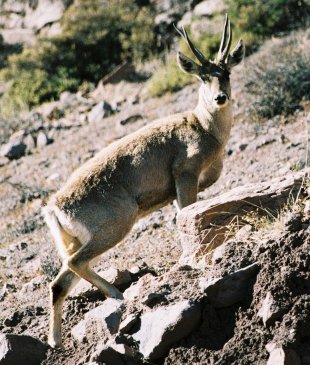
The taruca, also known as the Peruvian guemal, north Andean deer, north Andean huemul, northern huemul or northern guemal, is a mid sized deer species that inhabits the high regions of the Andes mountains in South America. The common name taruca means "deer" in both the Quechua and Aymara languages, though these are not interrelated. The taruca is closely related to the southern guemal, the only other member of the Hippocamelus genus.
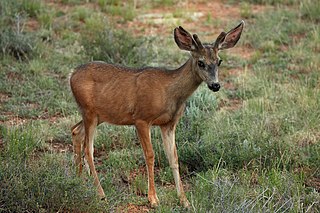
The Capreolinae, Odocoileinae, or the New World deer are a subfamily of deer. Alternatively, they are known as the telemetacarpal deer, due to their bone structure being different from the plesiometacarpal deer subfamily Cervinae. The telemetacarpal deer maintain their distal lateral metacarpals, while the plesiometacarpal deer maintain only their proximal lateral metacarpals. The Capreolinae are believed to have originated in the Middle Miocene, between 7.7 and 11.5 million years ago, in Central Asia.
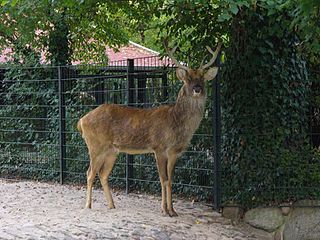
Rucervus is a genus of deer from India, Nepal, Indochina, and the Chinese island of Hainan. The only extant representatives, the barasingha or swamp deer and Eld's deer, are threatened by habitat loss and hunting; another species, Schomburgk’s deer, went extinct in 1938. Deer species found within the genus Rucervus are characterized by a specific antler structure, where the basal ramification is often supplemented with an additional small prong, and the middle tine is never present. The crown tines are inserted on the posterior side of the beam and may be bifurcated or fused into a small palmation.

Cervalces latifrons, the broad-fronted moose, or the giant moose was a giant species of deer that inhabited the Europe and Asia during the Pleistocene epoch. It is thought to be the ancestor of the modern moose, as well as the extinct North American Cervalces scotti. It was considerably larger than living moose, placing it as one of the largest deer to have ever lived.

Praemegaceros is an extinct genus of deer, known from the Pleistocene and Holocene of Western Eurasia. Praemegaceros is considered to be a genus of "giant deer", with many species having an estimated body mass of around 400 kilograms (880 lb), considerably larger than most living deer.
Morenelaphus is an extinct genus of capreoline deer that lived in South America during the Pleistocene, ranging from the Pampas to southern Bolivia and Northeast Brazil. There is only a single recognised species, Morenelaphus brachyceros. It was a large deer, with some specimens estimated to exceed 200 kilograms in body mass. The antlers were over 70 cm in length, and are superficially similar those of deer belonging to the subfamily Cervinae, like red deer. Fossils of the genus have been recovered from the Agua Blanca, Fortín Tres Pozos and Luján Formations of Argentina, the Ñuapua Formation of Bolivia, Santa Vitória do Palmar in southern Brazil, Paraguay and the Sopas Formation of Uruguay.
Agalmaceros is a potentially invalid extinct genus of deer of the Cervidae family, that lived in South America during the Pleistocene. The only species currently known is A. blicki. Remains have only been found in Ecuador. It showed a clear affinity to Andean or temperate habitats. Agalmaceros blicki is estimated to have been 60 kilograms (130 lb) in weight.

Bretzia pseudalces, is a species of deer from the extinct genus Bretzia It is endemic to North America, with fossils found in the Ringold Formation in Washington.
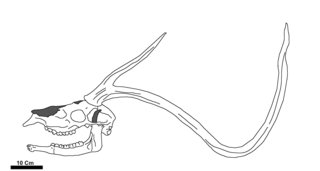
Haploidoceros is an extinct genus of deer that lived in Europe during the Pleistocene. It contains a single species, Haploidoceros mediterraneus. It had a distribution limited to southern France and the Iberian peninsula.

















